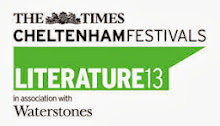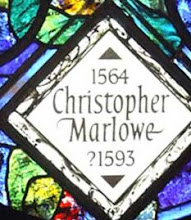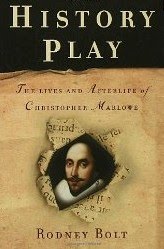Sunday, December 21, 2014
Rethinking the Sonnets: Ros Barber's Groundbreaking Article on Marlovian Perspective Now Available
Click here to read the first article exploring a "Marlovian"
perspective on Shakespeare's Sonnets to be published in a peer-reviewed
history journal: Rethinking History (June 2010). Ros Barber's "Exploring Biographical Fictions: the Role of Imagination in Writing and Reading Narrative" is now free to read on open access.
Thursday, September 18, 2014
Stylometrics and Edward II by Peter Farey
One piece of
stylometric evidence which seems at first sight to throw quite a large spanner
into the Marlovian works appears in Shakespeare,
Computers, and the Mystery of Authorship, edited by Hugh Craig and Arthur
F. Kinney.1 The book itself is not concerned with the Shakespeare
authorship question as such, but with whether certain parts of Shakespeare's
works or apocrypha are either by him or by a collaborator. For example, Craig
argues quite convincingly for Marlowe having made significant contributions to
parts one and two of Shakespeare's Henry
VI trilogy.
It is in a chapter called 'The authorship of The Raigne of Edward the Third' (by Timothy Irish West), however, that the item having most significance for the Marlovian theory appears. It is a chart (Fig.6.8, p.130) in which he is simply testing the validity of an approach being used to see whether Shakespeare wrote either the 'Countess' scenes (I.ii–II.ii) or the 'French campaign' scenes (III.i–IV.iii) in Edward III.
In this graph there are 90 shaded circles representing segments of 6000 words each from 27 plays which are taken to be solely by Shakespeare. There are also 236 diamond shapes representing 6000-word segments from 85 other single-author plays written between 1580 and 1619.
The horizontal (X) axis represents the extent to which each segment includes lexical words2 which have been identified as more characteristic of Shakespeare's works than the others'. The vertical (Y) axis shows the extent to which it uses words more typical of the others' works than Shakespeare's.3 Not surprisingly, they divide into two fairly distinct clusters – the circles in one and the diamonds in another.
In this particular chart, West has removed the three 6000-word segments of Marlowe's Edward II from the data, and treated them as if it were all of unknown authorship. Shown as black triangles on the chart, all three fall quite clearly within the 'other authors' cluster, and not within the 'Shakespeare' one. Here is the result. (The caption should of course read 'segments of Edward II', not 'segments of Edward III'.)
Against this, he shows (pp.127–8) segments from Shakespeare's King John, Henry IV (part 1) and Henry V, all of which fall in the 'Shakespeare' cluster, albeit at the edge nearest to the other one.
There is no doubt that this is a fairly strong piece of evidence that the author of Edward II (i.e. Marlowe) was not also the author of the Shakespeare canon. A few points need to be borne in mind, however, before we all admit defeat.
1. Although the data for Edward II are ignored in arriving at the characteristic words for the 'other authors', all of the rest of Marlowe's plays (except Dido, because of the possible input by Thomas Nashe) are included, whereas they would all need to be ignored too if the intention was to assess Marlowe as a Shakespeare authorship candidate – which it wasn't.
2. The three Henry VI plays, Titus Andronicus and The Taming of the Shrew – those which because of time proximity are most likely to have similarities to Marlowe – play no part in this calculation.
3. This also means that there is no play in the 'Shakespeare' set which is known to have been written less than five years or so after Edward II.
4. Furthermore, the Shakespeare set includes plays as late as The Tempest, written some twenty years later.
This question of date is of crucial importance in any stylometric attempt to assign authorship. Let me give an example which is in essence a very much simplified version of the method employed by Craig and Kinney (and West).
Suppose that there are two bodies of work, one which we will ascribe to playwright A and the other playwright B.
We work out that the frequency with which they each use the words 'most' and 'then' differs greatly. In fact, if we add up the total for both words in a play by either of them and find what percentage of them are 'most' we can be fairly sure that:
1Craig, Hugh; Kinney, Arthur F. (2009). Shakespeare, Computers, and the Mystery of Authorship. Cambridge University Press.
2According to Craig & Kinney (p.224), "Words can be classified into functional words and lexical words (with just a few doubtful cases). Function words have a grammatical function; examples are the, and, she, before, and of. [...] Lexical words [are] nouns, verbs, adjectives, and adverbs which can be substituted for each other in a given sentence." They give king and mother as examples.
3The most characteristic words for Shakespeare (the horizontal axis) are found by calculating the proportion of 'Shakespeare' segments within which a given word appears and adding this to the proportion of 'others' segments within which it does not appear (giving a theoretical maximum of +2). The 500 words with the highest scores are the ones used. For the vertical axis, the same procedure is followed, but finding those words with the highest combination of proportions 'within the others' and 'not within Shakespeare'.
It is in a chapter called 'The authorship of The Raigne of Edward the Third' (by Timothy Irish West), however, that the item having most significance for the Marlovian theory appears. It is a chart (Fig.6.8, p.130) in which he is simply testing the validity of an approach being used to see whether Shakespeare wrote either the 'Countess' scenes (I.ii–II.ii) or the 'French campaign' scenes (III.i–IV.iii) in Edward III.
In this graph there are 90 shaded circles representing segments of 6000 words each from 27 plays which are taken to be solely by Shakespeare. There are also 236 diamond shapes representing 6000-word segments from 85 other single-author plays written between 1580 and 1619.
The horizontal (X) axis represents the extent to which each segment includes lexical words2 which have been identified as more characteristic of Shakespeare's works than the others'. The vertical (Y) axis shows the extent to which it uses words more typical of the others' works than Shakespeare's.3 Not surprisingly, they divide into two fairly distinct clusters – the circles in one and the diamonds in another.
In this particular chart, West has removed the three 6000-word segments of Marlowe's Edward II from the data, and treated them as if it were all of unknown authorship. Shown as black triangles on the chart, all three fall quite clearly within the 'other authors' cluster, and not within the 'Shakespeare' one. Here is the result. (The caption should of course read 'segments of Edward II', not 'segments of Edward III'.)
Against this, he shows (pp.127–8) segments from Shakespeare's King John, Henry IV (part 1) and Henry V, all of which fall in the 'Shakespeare' cluster, albeit at the edge nearest to the other one.
There is no doubt that this is a fairly strong piece of evidence that the author of Edward II (i.e. Marlowe) was not also the author of the Shakespeare canon. A few points need to be borne in mind, however, before we all admit defeat.
1. Although the data for Edward II are ignored in arriving at the characteristic words for the 'other authors', all of the rest of Marlowe's plays (except Dido, because of the possible input by Thomas Nashe) are included, whereas they would all need to be ignored too if the intention was to assess Marlowe as a Shakespeare authorship candidate – which it wasn't.
2. The three Henry VI plays, Titus Andronicus and The Taming of the Shrew – those which because of time proximity are most likely to have similarities to Marlowe – play no part in this calculation.
3. This also means that there is no play in the 'Shakespeare' set which is known to have been written less than five years or so after Edward II.
4. Furthermore, the Shakespeare set includes plays as late as The Tempest, written some twenty years later.
This question of date is of crucial importance in any stylometric attempt to assign authorship. Let me give an example which is in essence a very much simplified version of the method employed by Craig and Kinney (and West).
Suppose that there are two bodies of work, one which we will ascribe to playwright A and the other playwright B.
We work out that the frequency with which they each use the words 'most' and 'then' differs greatly. In fact, if we add up the total for both words in a play by either of them and find what percentage of them are 'most' we can be fairly sure that:
* if it's
less than 40%, it's by playwright A
* if it's
more than 40%, it's by playwright B
(In fact
this works for all of A's 21 plays bar one, and all of B's 16 except two. You
would need to get a bit more complicated to get 100% in each case!)
Now let’s
imagine that we have a play where we suspect collaboration between the two
playwrights. We find that Acts 1 & 2 are well below 40% (so probably
playwright A) and Acts 3 & 5 well above (playwright B). Act 4 is more
doubtful at 43%.
So does this tell us anything at all about whether the two playwrights are different people? No. In fact playwright A is Shakespeare before 1600, and playwright B is Shakespeare after 1600. And Twelfth Night (1601?) was the play in question, if you were wondering.
What we can see, therefore, is that to claim that this tells us they were different people is circular reasoning. If you start with an assumption that they are two different people, and take no account of time, then it’s hardly surprising that this is just what the figures will seem to show.
Don't get me wrong, though. This is a powerful piece of evidence against the Marlovian theory, and it would be wrong to think otherwise.
So does this tell us anything at all about whether the two playwrights are different people? No. In fact playwright A is Shakespeare before 1600, and playwright B is Shakespeare after 1600. And Twelfth Night (1601?) was the play in question, if you were wondering.
What we can see, therefore, is that to claim that this tells us they were different people is circular reasoning. If you start with an assumption that they are two different people, and take no account of time, then it’s hardly surprising that this is just what the figures will seem to show.
Don't get me wrong, though. This is a powerful piece of evidence against the Marlovian theory, and it would be wrong to think otherwise.
© Peter
Farey, September 2014
1Craig, Hugh; Kinney, Arthur F. (2009). Shakespeare, Computers, and the Mystery of Authorship. Cambridge University Press.
2According to Craig & Kinney (p.224), "Words can be classified into functional words and lexical words (with just a few doubtful cases). Function words have a grammatical function; examples are the, and, she, before, and of. [...] Lexical words [are] nouns, verbs, adjectives, and adverbs which can be substituted for each other in a given sentence." They give king and mother as examples.
3The most characteristic words for Shakespeare (the horizontal axis) are found by calculating the proportion of 'Shakespeare' segments within which a given word appears and adding this to the proportion of 'others' segments within which it does not appear (giving a theoretical maximum of +2). The 500 words with the highest scores are the ones used. For the vertical axis, the same procedure is followed, but finding those words with the highest combination of proportions 'within the others' and 'not within Shakespeare'.
Monday, June 23, 2014
Is the Corpus Christi Portrait Marlowe?
Click here to read The Marlowe Society's post on the June 23 Times (U.K.) article concerning doubts about Marlowe being the sitter of the famous Corpus Christi portrait. Click here for Ros Barber's June 25 letter to the Times regarding this matter (via our International Marlowe-Shakespeare Society Facebook page).
Sunday, June 15, 2014
Worth Repeating: On the Shakespeare "Front"
A recent exchange on the "Oxfraud" Facebook page (commencing June 6), which consists of comments by International Marlowe-Shakespeare Society members Peter Farey and Daryl Pinksen, has prompted this blog to re-post two older blog articles on the issue of Shakespeare being a front for another, possibly blacklisted writer. In "Philip Yordan: A Modern-Day Shakespeare?" Daryl Pinksen examines some compelling parallels between Marlowe and the Hollywood blacklisting of the 1950s. In "William Shakespeare, Businessman - Forgotten Genius," Anthony Kellett also explores the life of a literary front man. We welcome your comments to these provocative pieces.
Tuesday, May 6, 2014
Monsieur Le Doux was European scholar Catharinus Dulcis (1540-1626) by Geoffrey Caveney and Peter Farey
Readers of this blog are probably well familiar with Monsieur Le Doux, who in 1595 was a tutor at the home of Sir John Harington in Rutland, was instructed on the gathering of intelligence for the Earl of Essex and Anthony Bacon in 1596, and whose name appears briefly in Thomas Birch's Memoirs of the Reign of Queen Elizabeth and in Bacon's papers. We had believed until very recently that Le Doux might have been an identity for the surviving Christopher Marlowe in hiding. But we now know this was not the case.
In fact, this Monsieur Le Doux was
Catharinus Dulcis or Catherin Le Doux, a reputable European scholar of the
Italian and French languages. He was born in Savoy in 1540, worked for a long
time as an itinerant tutor to young noblemen, and became a professor of Italian
and French at the University of Marburg in Germany in 1605. He compiled an
Italian-Latin dictionary, translated works by Tasso and Terence, and wrote a
comedy of his own, Tobie (Tobias).
Much information about his life can be found at this German website.
Marburg was the world's first
Protestant-founded university, and in fact Dulcis's Protestant beliefs were the
reason he had to leave the Continent and stay in England as Monsieur Le Doux in
the period 1594-1596.
Co-author Caveney first discovered the
identity of Le Doux as Dulcis in a letter Dulcis wrote from London in November
1594 to Sir John Skene. It appears on pp. 156-157 of the book Memorials of the family of Skene of Skene...,
published in 1887. The letter is written in French and signed "Le
Doulx," and below it, "CATHARINUS DULCIS". Among other things in
the letter, he mentions the kindness and courtesy of Anthony Bacon.
Further research by the two of us has
uncovered abundant confirming information that clearly shows that this man must
have been Monsieur Le Doux. Dulcis's own autobiographical sketch Vitae Curriculi Breviarium, written in
Latin, mentions his time in England working for Essex and Bacon and even
tutoring for the Haringtons, the main activity of Le Doux that we knew of from
Bacon's papers. This work of Dulcis also mentions Antonio Perez, Mittelburg,
Baron Zeirotine, Count Maurice of Nassau, Archduke Albert and Henri d'Eberbach,
all figures who appeared in Le Doux's correspondence as we knew it.
Finally, co-author Farey examined a letter
by Dulcis in 1607 and found that the handwriting and signature are so similar
to those found in the letters that we have of Monsieur Le Doux, that it is
quite clear that they were written by the same person.
© Geoffrey Caveney and Peter Farey, May 2014
© Geoffrey Caveney and Peter Farey, May 2014
Tuesday, March 25, 2014
DIO, the International Journal of Scientific History on Marlowe-as-Shakespeare
Click here to read Dennis Rawlins's truly compelling (and highly amusing) paper entitled "Marlowe Created Shakespeare" in the latest issue of DIO, the International Journal of Scientific History. Since 1991, DIO has held an interest in exposing historical hoaxes of various types (read about their work regarding the North Pole discovery here in the New York Times). International Marlowe-Shakespeare Society members Peter Farey, Ros Barber, and Samuel Blumenfeld receive nice plugs in Rawlins's must-read paper.
Friday, March 14, 2014
Tuesday, February 4, 2014
Did Christopher Marlowe Fake His Death?
Read Ros Barber's piece "Did Christopher Marlowe Fake His Death?" in today's Huffington Post. Ros, a regular contributor to this blog, is the author of The Marlowe Papers and a founding member of the International Marlowe-Shakespeare Society.
Saturday, February 1, 2014
Romeo and Juliet and Marlowe and Nashe by Donna N. Murphy
Marlovians have long maintained that Christopher Marlowe, about to be imprisoned and probably executed as a “heretic,” faked his own death and afterwards wrote work that was published under the name “William Shakespeare.” My research has additionally found linguistic evidence that Marlowe’s friend Thomas Nashe, like Marlowe hounded by the Church of England, pretended to die and assumed the identity of Thomas Dekker (see The Mysterious Connection between Thomas Nashe, Thomas Dekker and T. M.: An English Renaissance Deception?). In The Marlowe-Shakespeare Continuum, I maintain that Marlowe and humorist Nashe co-authored plays, including some within the Shakespeare canon. Following is a selection of material from my chapter on Romeo and Juliet.
In Romeo and Juliet, the excellent plotting, the poetry of love, and
the language of the nobility is, in my view, Marlowe’s, but Nashe penned lines
by servants and by Mercutio, who even as he is dying makes a pun, “Tomorrow you
shall find me a grave man.” Listen, and you can hear the difference1
Marlovian:
Romeo. But, soft! What light through yonder window breaks?
It is the east, and
Juliet is the sun!
Arise, fair sun, and kill the envious moon,
Who is already sick and pale with grief,
That thou her maid art far more fair than she. (II.i.44-48)
Nasheian:
Mercutio. The pox of such antick, lisping, affecting fantasticoes,
these new turners of accents!—‘By Jesu, a very good blade!—a very tall man! A
very good whore.’—Why, is not this a lamentable thing, grandsire, that we
should be thus afflicted with these strange flies, these fashion-mongers... (II.iii.26-31)
Romeo
and Juliet and Marlowe
Marlowe’s work is tied in rare ways
to Romeo and Juliet. To demonstrate
this, I ran word juxtapositions through the Early
English Books Online-Text Creation Partnership (EEBO), a searchable database made up of over
32,000 texts of works written from 1472 to 1700 at
the time of my study. I have adopted the following EEBO terminology: “fby.10” = “followed by,” the second term follows
within ten words of the first term; “near.20” = the second term occurs within
twenty words either before or after the first; and “*” = a placeholder for
endings.
1. Shakespeare and Marlowe works contain the only two occurrences in EEBO
of Gallop* apace near.100 Phoebus* near.100 night*. The speakers in both
excerpts express their desire for night to come quickly by telling Phoebus and
his horses to “gallop apace” through the sky.
Romeo
and Juliet:
Gallop apace, you fiery-footed
steeds,
Towards Phoebus’ lodging. Such a waggoner
As
Phaëton would whip you to the west
And bring
in cloudy night immediately.
Spread
thy close curtain, love-performing night,
That
runaways’ eyes may wink, and Romeo
Leap to
these arms untalked of and unseen. (III.ii.1-7)
Marlowe’s Edward II:
Gallop apace, bright Phoebus, through the sky,
And dusky
night, in rusty iron car,
Between
you both shorten the time, I pray,
That I
may see the most desirèd day
When we
may meet these traitors in the field. (Sc. xvi.44-8)
2. Romeo and Juliet and Marlowe's translation of Lucan’s First Book sport the
only two occurrences in EEBO of Cloud* near.100 meteor* near.100 torch*
near.100 night*. The passages also juxtapose “day,” “light,” and “east.” Now,
works did circulate in manuscript, but it is worth noting that Lucan’s First
Book, Marlowe's The Jew of Malta, and Marlowe's Hero and Leander were unpublished
when Romeo and Juliet was written.
Romeo
and Juliet:
Marlowe’s Lucan’s First Book:
And sundry fiery meteors blazed in heaven,
Now spear-like, long, now like a
spreading torch;
Lightning in silence stole
forth without clouds,
And from the northern climate
snatching fire
Blasted the Capitol; the lesser
stars,
Which wont to run their course
through empty night,
At noonday mustered; Phoebe having filled
Her meeting horns to match her
brother’s light,
Strook with th’ earth’s sudden
shadow, waxèd pale;
Titan himself throned in the midst of
heaven
His burning chariot plunged in sable clouds,
And whelmed the world in darkness,
making men
Despair of day, as did Thyestes’ town,
Mycenae, Phoebus flying through the east. (529-42)
3. Below are the only two occurrences of “Sweetest flower near.20 field” in EEBO for forty years before and after the excerpts were written. Romeo
and Juliet is describing Juliet, who is not quite fourteen, while The Jew of Malta’s subject, Abigail, is
scarce fourteen. This juxtaposition seems to indicate the same mind at work.
Romeo
and Juliet:
Death lies on her like an untimely frost
Upon the sweetest flower of all the field (IV.iv.55-6)
Marlowe’s The Jew of Malta:
A fair young maid, scarce fourteen years of age,
The sweetest flower in Cytherea’s field
(I.iii.13-4)
4. Following are two out
of three of the occurrences of “amorous rite*” for forty years before or after
the works’ composition. The third occurrence is in George Chapman’s play All Fools, printed in 1605.
Romeo
and Juliet:
Lovers can see to do their amorous rites (III.ii.8)
Marlowe’s Hero and Leander:
Some amorous rites
or other were neglected (Sestiad II.64)
5. Other striking parallels include:
Romeo
and Juliet:
But soft, what light through yonder window breaks?
It is the east, and Juliet is the sun.
(II.i.44-5)
Marlowe’s The Jew of Malta:
But stay, what star shines yonder in the east?
The lodestar of my life, if Abigail. (II.i.41-2)
6. Romeo and Juliet:
Come,
death, and welcome (III.v.24)
Marlowe’s Edward
II:
Then come, sweet death, and
rid me of this grief (Sc. xxvi.92)
7. Romeo and Juliet:
Eyes, look your last!...
The dashing rocks thy
seasick weary barque! (V.iii.112, 118)
Marlowe’s II Tamburlaine:
Now, eyes, enjoy your latest
[last] benefit…
Through rocks more steep
and sharp than Caspian cliffs (V.iii.224, 241)
In Romeo
and Juliet, Romeo refers to viewing his deceased wife,
Juliet, in the last scene of the play, before he kills himself. In II Tamburlaine, Tamburlaine refers to viewing his deceased wife, Zenocrate, in the
last scene of the play, before he dies.
Other
Marlowe Connections
Beyond linguistic ties, biographical connections exist as well. Juliet was sixteen years old in the main source for Romeo and Juliet, Arthur Brooke’s
poem The Tragical History of Romeus and
Juliet, and scholars are not sure why Shakespeare made her younger.
According to the play, Juliet was born on Lammas Eve (August 20). As Louis Ule
noted, Marlowe had a sister named Joan (or Jane) who was baptized on Lammas Eve
and married young, at age 12 ½. She died in childbirth a year later, when she
was the same age as Juliet.2 Marlowe had a personal reason to view the death of a newly married girl not yet
fourteen years old as particularly tragic.
In 1589, Marlowe got into a fight with William
Bradley for an unknown reason. Marlowe’s friend Thomas Watson came upon them
and drew his sword, saying that he did so to separate them and to preserve the
peace. Marlowe withdrew and Bradley and Watson dueled, with Watson stabbing
Bradley to death, he said, in self-defense. Marlowe’s biographer John Bakeless
suggested that this incident inspired the scene in Romeo and Juliet where Romeo comes between the dueling Mercutio and
Tybalt in order to separate them, instead giving Tybalt an opening to stab
Mercutio to death.3
Romeo and Juliet’s
tone is quite different from The Tragical History of Romeus and Juliet,
which took a medieval, moralistic approach. In his Epistle, Brooke droned on
about “A couple of unfortunate lovers, thralling themselves to unhonest desire;
neglecting the authority and advice of parents and friends; conferring their
principal counsels with drunken gossips and superstitious friars (the naturally
fit instruments of unchastity).”4 Instead, the tone
of Romeo and Juliet is of an
impetuous, exuberant, passionate young love: exactly the same tone as Marlowe's Hero
and Leander. Indeed, Harold R.
Walley envisioned Shakespeare penning Romeo
and Juliet with Hero and Leander
at his elbow.5
Shakespeare squirreled away two sonnets in Romeo and Juliet — poems of fourteen lines that express a single
thought. The first is in the Prologue, and the second is cleverly incorporated
into the lovers’ first meeting:
To
smooth that rough touch with a tender kiss.
Which
mannerly devotion shows in this.
For saints have hands that pilgrims’ hands do touch,
And palm to palm is holy palmers’ kiss.
Romeo. Have not saints lips, and holy
palmers, too?
Juliet. Ay, pilgrim, lips that they must
use in prayer.
They
pray; grant thou, lest faith turn to despair.
Juliet.
Saints do not move, though grant for
prayers’ sake.
Romeo. Then move not, while my prayer’s effect I take.
(I.v.92-95)
Paul H. Kocher and Roy T. Eriksen located
sonnets within Marlowe’s plays I and II Tamburlaine.6 For example:Romeo. Then move not, while my prayer’s effect I take.
(I.v.92-95)
Marlowe’s I Tamburlaine:
What is beauty, saith my sufferings,
then?
If all the pens that ever poets held
Had fed the feeling of their masters’
thoughts,
And every sweetness that inspired
their hearts,
Their minds and muses on admirèd
themes;
If all the heavenly quintessence they
still
From their immortal flowers of poesy,
Wherein as in a mirror we perceive
The highest reaches of a human wit;
If these had made one poem’s period,
And all combined in beauty’s
worthiness,
Yet should there hover in their
restless heads,
One thought, one grace, one wonder at
the least,
Which into words no virtue can
digest. (V.i.160-73)
While Marlowe’s sonnets were
unrhymed, he proved himself a master of rhyme in Hero and Leander, and included the paired sake/take line endings
found in Romeo and Juliet.
Marlowe’s Hero and Leander:
If not for love, yet, love, for pity sake,
Me in thy bed and maiden bosom take (Sestiad II.247-8)
Romeo
and Juliet and Nashe and Dekker
While much of Romeo and Juliet is Marlovian, portions are just as surely Nasheian
or, as Stanley Wells responded to his own question about where the Bard derived
the style of the Nurse’s speech at I.iii.12-60, “I suspect it is relevant that,
at about the time the play was composed, Thomas Nashe was demonstrating his
capacity in what he calls the ‘extemporal vein.’”7
Let us begin by discussing two rare
similarities in EEBO shared by Romeo and Juliet, Thomas Nashe and Thomas Dekker
(whom I find to have been one and the same person).
1. In Nashe’s Have With You to Saffron-Walden we hear: “Then there would be old scratching…Not Tibault or Isegrim, Prince of Cats, were ever
endowed with the like Title./ Respondent. Since
you can make so much of a little, you shall have more of it,” “A common Mountebank
Rat-catcher,” and “What a stomach
I had to have scratched with him”
(H3r-v, L1r, O4r). Nashe sometimes worked from memory without double-checking
for accuracy, a trait editor Ronald B. McKerrow found disturbing as this made
it difficult to identify references in Nashe’s works.8 Here Nashe misremembered “Tybert,”
the name of the cat in William Caxton’s 1481 translation of the moral
fable Reynard the Fox, as “Tibault.”
As Joan Ozark Holmer pointed out, Nashe derived “Isegrim” from the name of a
female cat in William Baldwin’s Beware the Cat, a book which also contains the phrase “prince of
cats.” Holmer maintained that Nashe’s “prince of cats” is a vocative addressing
Gabriel Harvey, whom Nashe later called a “rat
catcher.”9
In
Romeo and Juliet appears “Benvolio. Why, what is Tybalt?/ Mercutio. More than Prince of Cats,” plus “Tybalt,
you rat-catcher…Good King of Cats…scratch a man to death” (II.iii.17-8 and III.i.74, 76, 101). Here
the thinking is quite like Nashe’s. Tybalt, like Gabriel Harvey (as Nashe
portrays him), is an arrogant enemy. “Prince of cats” and “rat catcher” refer
to the same person, Tybalt in Romeo and
Juliet and Harvey in Have With You to
Saffron-Walden, although in neither instance are these epithets located
near each other, as might be expected if one author were copying another. Both
works collocate “prince of cats” and “more,” and both equate scratching with
fighting.
Finally,
in Dekker’s Satiro-Mastix, we find “A Scratching
of men’s faces, as though you were Tyber
the long-tail’d Prince of Rats”
(L3v), addressed to the arrogant enemy, Horace. Again there is a faulty memory,
with “Tyber” instead of “Tybert.” Tyber is associated with scratching men, as
Tybalt “scratched” Mercutio. The juxtaposition of the name “Tyber” with “prince
of rats,” however, takes us back in indirect fashion to Nashe’s commixture of
the same two sources: Caxton’s Reynard
the Fox for Tiber/Tibault, and Baldwin’s Beware
the Cat for prince of cats/rats. To me, the same mind appears to be at work
in all three pieces. These are the only appearances of Tib* near.30 prince* of
rat*/cat* in EEBO.
2.
The first quarto of Romeo and Juliet, Nashe
and Dekker all share the rare word “fantastico*.” Romeo and Juliet: “The Pox of such limping antique affecting fantasticoes these new tuners of accents” (1597 Quarto E1v). The First Folio version
of Romeo and Juliet has “phantacies” (II.iii.27),
but this is often emended to “fantasticoes” because it makes better sense. In
Nashe’s Have With You to Saffron-Walden is: “These new fangled Galiardos, and Senior Fantasticos, to whose amorous Villanellas and Quipassas, I prostitute my pen in hopes of gain” (E3v). The word also occurs in Dekker’s Old Fortunatus: “I have reveled with kings, danc’d with Queens,
dallied with Ladies, worn strange attires, seen fantasticoes” (E1r). I find but one other appearance of
“fantastico(s)” in an English sentence in EEBO,
The Good Woman’s Champion by I. A.,
1650. The Romeo and Juliet and Old Fortunatus occurrences are the only
examples listed in the Oxford English
Dictionary.
Bawdy Language
4. Both Shakespeare and Nashe
associate “setting up one’s rest” with resting little during the night because
of a couple’s love-making. Romeo and
Juliet: “The County Paris hath set
up his rest/ That you shall rest but
little” (IV.iv.33-4) vs. Nashe’s Terrors
of the Night:
“You that are married and have wives of your own, and yet hold too near
frendship with your neighbors; set up your
rests, that the Night will be an ill
neighbor to your rest” (H2r).
5. Both Shakespeare and Dekker mix
the proverb about the weakest going to the wall with the female sex to create
bawdy puns. Romeo
and Juliet: “Samson. I will take the wall of any man or maid of
Montague’s./ Gregory. That shows thee
a weak slave, for the weakest goes to
the wall./ Samson. ‘Tis true, and
therefore women, being the weaker
vessels, are ever thrust to the wall;
therefore I will push Montague’s men from the wall, and thrust his maids to the wall” (I.i.10-7) vs. Dekker’s The Bloody Banquet: “Oh always the
weakest goes to the wall, as for example, knock down a sheep and he tumbles
forwards, knock down a woman and she
tumbles backwards” (C2v). The same type of sexual punning occurs in Nashe’s Choice of Valentines: “Poor Priapus, whose triumph now must fall,/ Except thou
thrust this weakling to the wall”
(257-8). Priapus is the god of male genitalia. Note also Nashe’s Preface to Astrophel & Stella:
“No bones to take the wall of Sir
Philip Sidney” (M2v).
Assorted Similarities
6. Romeo
and Juliet: “For then she could stand high-lone” (I.iii.38) vs. Dekker’s Blurt Master Constable: “When I could not stand a high-lone” (D2v). Stand*/stood near.20 high lone is rare in
EEBO. “High lone” means alone,
without support.
7. Romeo and Juliet: “Let wantons light of heart/ Tickle the sense-less rushes with their heels” (I.iv.35-6) vs. Dekker’s Blurt Master Constable:
“Lady, bid him whose heart no sorrow
feels/ Tickle the rushes with his wanton heeles” (A4v). Rushes near.30
tickle* near.30 wanton* is also rare in EEBO.
8. Romeo and Juliet:
“Then music with her silver sound—/ Why ‘silver sound’, why ‘music
with her silver
sound?’…It is ‘music with her
silver sound’ because musicians have no gold for sounding./ Then music with her silver sound”
(IV.iv.154-5, 165-7) vs. Dekker’s Old
Fortunatus: “Here’s no sweet Music with her silver sound” (B3v). The
source of “Music with her silver sound” is
The Paradise of Dainty Devices
by Richard Edwards, 1585; the phrase is otherwise rare in EEBO.
9. Romeo and Juliet: “Mercutio. You gave us the counterfeit
fairly last night./ Romeo. Good
morrow to you both. What counterfeit did
I give you?/ Mercutio. The slip, sir,
the slip” (II.iii.42-6) vs. Nashe’s The Unfortunate Traveler: “Aye me, she was but a counterfeit slip, for she not only gave me the slip” (F1v).
Both excerpts pun by mixing the expression “to give the slip,” meaning to
escape, with the knowledge that a counterfeit coin is called a “slip.”
10. Romeo and Juliet: “Nay, good goose, bite not.”
(II.iii.73) vs. Nashe’s Strange News: “Good
bear, bite not.” (T3v), repeated two times in Have With You to Saffron-Walden (T3r)
after Gabriel Harvey criticized Nashe for the phrase in Pierce’s Supererogation.
11. Romeo and Juliet: “Nurse. My fan, Peter./ Mercutio.
Good Peter, to hide her face, for her fan’s the fairer face”
(II.iii.98-100) vs. Dekker’s The
Shoemaker’s Holiday: “Wife. I
must get me a fan or else a mask./ Roger. So you had need, to hide your wicked face” (III.ii.45-6).
For additional similarities between Romeo and Juliet and the works of
Marlowe, Nashe and Dekker, and for more in-depth explanation, please see the chapter
about the play in The
Marlowe-Shakespeare Continuum: Christopher Marlowe, Thomas Nashe, and the
Authorship of Early Shakespeare and Anonymous Plays.
©
Donna N. Murphy, January 2014
Donna N. Murphy is the co-winner the 2010 Calvin and Rose G. Hoffman Prize for a Distinguished Publication on Christopher Marlowe.
Donna N. Murphy is the co-winner the 2010 Calvin and Rose G. Hoffman Prize for a Distinguished Publication on Christopher Marlowe.
1Sources for quotes: Christopher Marlowe. The Complete
Plays, edited by Frank Romany and Robert Lindsey (New York: Penguin Books,
2003); Christopher Marlowe. The
Complete Poems and Translations, ed. Stephen Orgel (New York: Penguin
Books, 2007); and William Shakespeare,
The Complete Works, general editors Stanley Wells and Gary Taylor (Oxford:
Oxford University Press, 2005). For Thomas Nashe and Thomas Dekker, sources are
the original works in The Early English
Books Online database, usually the first editions. Spelling and orthography
have been modernized.
2Louis Ule, Christopher Marlowe (1564-1607). A Biography
(New York: Carlton Press Corp, 1995), 2-3.
3John Bakeless, Christopher Marlowe: the Man in his Time
(New York: William Morrow and Company, 1937), 157.
4Arthur Brooke, Brooke’s
‘Romeus and Juliet,’ ed. J. J. Munro (London: Chatto & Winders,
1908), epistle To the Reader, as quoted in Harold R. Walley, “Shakespeare’s
Debt to Marlowe in Romeo and Juliet,”
Philological Quarterly 21 (1942):
257-67, 259.
5Walley, 267. Others have speculated that Shakespeare wrote Venus and Adonis with Hero and Leander nearby.
6Paul H. Kocher, “A Marlowe Sonnet,” Philological Quarterly 24 (1945): 39-45, 39-40; and R. T. Eriksen,
“Marlowe’s Petrarch: In Morte di Madonna
Laura,” Cahiers Élisabéthains 29
(1986): 13-25.
7Stanley Wells, “Juliet’s Nurse: the uses of
inconsequentiality,” in Shakespeare’s
Styles, ed. Philip Edwards, et al (Cambridge: Cambridge University Press,
1980), 51-66, 64.
8See discussion in Donald J. McGinn, “Nashe’s Share in the
Marprelate Controversy,” Publications of
the Modern Language Association of America 59 (1944): 952-84, 972-3.
9Joan Ozark Holmer, “Nashe as ‘Monarch of Witt’ and
Shakespeare’s Romeo and Juliet,” Texas Studies in Literature and Language
37 (1995): 314-43, 315-7.
Subscribe to:
Posts (Atom)





















